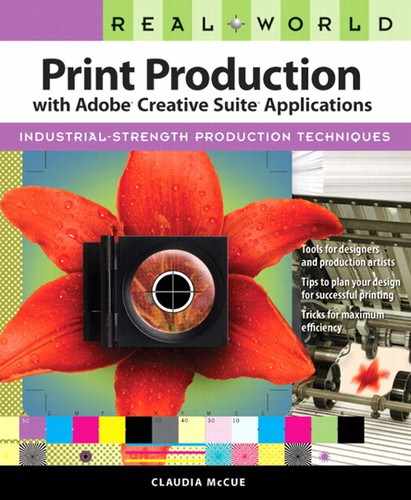OpenType Fonts
OpenType fonts are single-file fonts and do not have separate screen and printer fonts to keep track of. But here’s where the real font fun begins. OpenType fonts are cross platform. This doesn’t mean that Adobe Garamond Pro comes in a Macintosh version and an identical Windows version. Instead, the same font file can be used on a Mac or on a PC with no special handling.
But, as the late night TV ads say: Wait, there’s more. Whereas PostScript fonts are limited to a paltry 256 characters (isn’t that enough?), OpenType fonts can contain more than 65,000 glyphs. A glyph is any distinct letterform, such as a number, a lowercase p, or an ampersand. This allows a font designer to include swashes, contextual ligatures, titling alternates—even fractions—all in one font. The entirety of a font family that previously required separate expert and titling sets can now be contained in one font. See Figure 6.1 for a glimpse of just a few of OpenType’s possibilities.
Figure 6.1. Adobe Garamond Pro is a lovely font even without invoking its special OpenType features (top). But look what happens when Swashes and Discretionary Ligatures are turned on (bottom).

Not all OpenType fonts contain glyphs in every one of those 65,000 available character positions. For example, one font may have swashes, but another may not. However, the adherence to Unicode mapping ensures that a character exists in the same position from font to font. Unicode is a standard that provides a unique universal identifier for every character, regardless of language, application, or platform. For more information, visit the Unicode Web site (www.unicode.org). If you set text using some of the special diacritical characters in Caslon Pro, for example, and then change the font used to Garamond Pro, the diacriticals (special language characters, such as á, ä, and ç) are intact because they exist in both fonts.
You can use OpenType fonts without fear of imaging problems. They are compatible with all recent RIPs, and all current font-management software supports OpenType. Not using font-management software? OpenType fonts can be activated by the built-in Font Book application on the Macintosh and by the Windows Fonts control panel. Or you can drop them in the Macintosh system fonts folders to make them available to all applications (although it’s preferable to use font-management software). And having OpenType fonts doesn’t mean you have to stop using the PostScript and TrueType fonts you already have.
The benefits of OpenType extend far beyond typographic beauty. One of the motivations for the OpenType format was to provide multilingual support. In Figure 6.2, you can see the extensive character set in just one font, Myriad Pro from Adobe Systems.
Figure 6.2. Multilingual support available within the OpenType font Myriad Pro, viewed in the InDesign Glyphs panel.

You won’t be able to use all 65,000 glyphs unless you’re using software that recognizes the additional features. Adobe InDesign, Illustrator, and Photoshop can see and use the entire contents of an OpenType font, whereas QuarkXPress through version 6.5 has blinders on, and it can only utilize the same old 256 characters. QuarkXPress 7.0 introduces support for the complete range of OpenType features.
Adobe has converted its entire font library to OpenType and will no longer be offering PostScript Type 1 fonts. It’s easy to spot OpenType fonts from Adobe: They have Std or Pro as part of their names. Adobe is not the only font vendor marketing OpenType fonts. Most major font vendors now offer OpenType. Given the linguistic support and the enhanced typographic features offered by OpenType fonts, it’s easy to see that it’s the font format of the future. And it’s here today, unlike those flying automobiles we’ve been waiting for.
Note
The Std is short for Standard, indicating an Adobe OpenType version of a previously available PostScript Type 1 font. Adobe OpenType fonts with the Pro indicator have more expanded glyph sets and are often the result of combining what once were expert font sets and their base companions.
Glyphs and CharactersIt’s easy to confuse the terms character and glyph, but they describe different concepts. A character corresponds to a single position in the Unicode standard, which is a uniform, agreed-upon mapping system for the contents of a font. A glyph, however, is a distinct letterform. Multiple glyphs may exist for a single character position in an OpenType font, such as |
